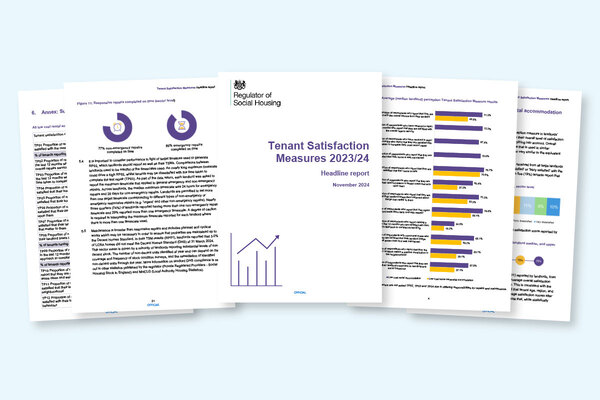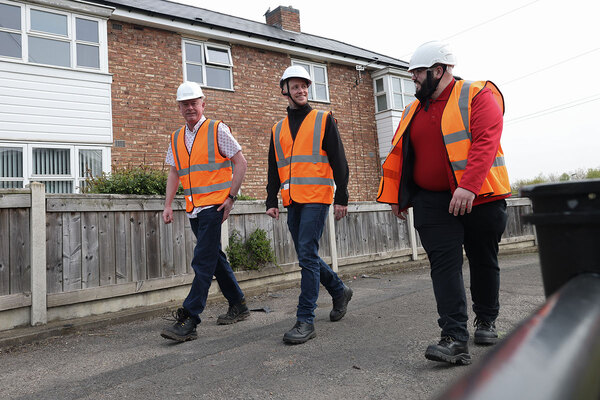You are viewing 1 of your 1 free articles
6 things we learned from the first year of the TSMs
The Regulator of Social Housing (RSH) has published the results of the tenant satisfaction measures (TSMs) for 2023-24. Grainne Cuffe shares six key takeaways from the first year
Last week, the regulator published the TSM scores of nearly 360 landlords that each have 1,000 or more homes.
A major part of the regulatory reform of the sector, the results from the first year of the TSMs revealed that seven in 10 social housing tenants are either very or fairly satisfied with their landlord, compared with just under half of shared owners.
The 22 measures, part of the English regulator’s Transparency, Influence and Accountability Standard, are split into 10 metrics based on landlord health and safety data, and 12 based on tenant perception surveys.
The latter covers topics such as repairs, complaint-handling, anti-social behaviour, and whether tenants feel listened to and respected.
The surveys are now the main way tenants can express how they feel about their social landlord. The RSH also published the findings of its National Tenant Survey, which involved 3,500 social housing tenants and shared owners.
Fiona MacGregor, chief executive of the RSH, said landlords should “already be reflecting” on their results and “using them to improve their services”.
Below, Inside Housing goes through the main takeaways from the first year of the TSMs.
Collection methods impact results
As Inside Housing reported several times, the regulator concluded from the data that the methods used to do the surveys have an impact on scores. In fact, it has published the TSM data in such a way that predominant survey methods are grouped together to make it easier to compare like for like.
Of the landlords that submitted data, 65% used telephone surveys as their predominant collection method, while only small numbers of landlords used internet, postal or face-to-face methods as their main approach.
According to the RSH’s analysis: “Landlords have reported overall satisfaction scores for each collection method used to the regulator.
“This evidence suggests a significant impact of survey collection method on the satisfaction score, including in collection methods where staff and contractors ask tenants the questions and report their response.
“For example, while telephone surveys had an average satisfaction of 70%, average scores for internet surveys (58%) were significantly lower and for face-to-face surveys significantly higher (75%).”
The report said the regulator considers the predominant survey collection method “fundamental context” to assessing each landlord’s satisfaction scores and that this is “especially the case for landlords” using a method that “diverges from that commonly used” by others.
Repairs are key
The regulator’s analysis concluded that repairs and maintenance services appear to be the most significant specific drivers of overall satisfaction among tenants.
It found that 64% of tenants who were dissatisfied with overall landlord services cited repairs issues as the reason.
According to the report on the National Tenant Survey: “Undertaking repairs are a key part of a property being well maintained and those that take a long time to resolve or are outstanding are a main source of dissatisfaction.
“Well-maintained properties, which is a key driver of overall satisfaction, is mentioned in relation to repairs and more generally (11%).
“Other wider areas of maintenance such as communal areas (6%) and greenery (1%) are also cited. Customer service is also an area of dissatisfaction (16%), as are costs (8%).”
Age matters
When looking at the link between tenant characteristics and overall satisfaction, age was found to have the biggest impact.
The regulator found that tenants over 65 have significantly higher average overall satisfaction (82%) compared with other age groups.
Tenants aged between 16 and 34 are on average 69% satisfied, compared with 63% for those aged 35 to 54 and 67% for those aged 55 to 65.
“There is significant evidence that tenants who state they have a physical or mental health condition are less satisfied than tenants who do not have a disability, although the difference in overall satisfaction between these two groups is relatively small (68% vs 71%),” the regulator found.
It also found that female tenants are significantly less satisfied than male tenants in terms of overall satisfaction – 67% vs 75%.
According to the National Tenant Survey report: “There is some indication that tenants who would describe their ethnicity as white are more satisfied than other tenants.
“However, regression analysis suggests that this is likely to be due to other characteristics of this cohort (eg 32% of white tenants are aged 65 or over, compared to just 6% of minority ethnic tenants) – there is no significant impact of ethnicity on average satisfaction controlling for other factors.”
The data also showed that people in supported housing are more satisfied – on average 77.5% – than those who are not.
The RSH said this may be affected by the higher number of older tenants in supported accommodation, and a potential reflection of the additional services typically provided by specialist landlords.
London lows
The data shows that tenants living in London are significantly less satisfied than those outside the capital, with an average satisfaction score of 61%.
This compares with 73% in the North, 71% in the South and 72% in the Midlands.
“When combining region with urban and rural classifications, we find that tenants in London are also significantly less satisfied than tenants living in both rural areas and other urban areas,” the regulator found.
It found that lower satisfaction in London is evident “even after controlling for all other factors”, such as age, property type or neighbourhood deprivation.
Shared owners
The findings revealed that shared owners are on average much less satisfied overall when compared with social housing tenants, with just under half satisfied with the service provided by their landlord.
For shared owners, levels of satisfaction for the TSM on whether the landlord listens to tenant views and acts upon them was 44%, and 24% for complaint-handling.
Where shared owners are dissatisfied, their reasons include rent or service charges (38%), repairs issues (33%) and general customer service (26%).
According to the National Survey Report: “Some of the responses appeared to reflect perceptions over the value for money provided under the shared ownership model – for example, shared owners cite that they pay rent without the repairs service received by other tenants.
“However, many shared owners cite specific issues with repairs and other services which landlords provide to them (eg maintenance of communal areas).”
Shared owners cited failure to carry out necessary maintenance on grounds and buildings as reasons for their dissatisfaction. They also cited lack of communication and representation, no consultation about trades and companies used, and the fact that they have to pay for 100% of repairs, despite only owning some of the property.
They said service charges are “not clear”.
Complaint-handling
The TSM data showed complaint-handling is one of the main areas landlords can improve upon. Tenants reported an average satisfaction score of 34.5%, the lowest across all measures.
According to the regulator: “The lower result compared to other TSMs suggests that landlords need to understand why tenants report dissatisfaction with complaints-handling and identify ways to improve landlord services.
“The National Tenant Survey sets out the range of issues which generates dissatisfaction with complaint-handling, which can have a powerful impact on overall tenant satisfaction. Resolving issues identified... can therefore also improve satisfaction more generally.”
It found that repairs and maintenance issues constitute the majority of issues tenants report complaining about (59%).
Particular issues include taking too long to deal with repairs, damp and mould, issues with plumbing and heating, and poor quality of workmanship.
When tenants were asked what could improve the complaint-handling process, they said improving customer service, responding quicker and better communication.
Last week, Richard Blakeway, the housing ombudsman, discussed lessons to be learned from the findings.
Sign up for our regulation and legal newsletter
Already have an account? Click here to manage your newsletters











